Laser in medicine
The term laser brings to mind high-tech and precision. The patient expects an innovative and gentle treatment from a laser operation. The power of the focused light should prevent bleeding and recurrence and guarantee a short healing time.
This is why we have been using this technology since 2011. At Pilonidal Sinus Laser OP, a distinction is made between thermal sclerotherapy (FiLaC/SiLaC) and the removal of the fistula with a laser scalpel (laser sinusectomy).
In the post-operative treatment of a pilonidal sinus, Low Level Laser Therapy (LLLT) and laser hair removal are used.
- Laser beams are monochromatic: visible light contains a continuous spectrum. The laser delivers a precisely defined wavelength. The selection of the wavelength controls where and how the laser works in the tissue.
- One uses the effect of the selective photothermolysis. This means that a target structure (chromophore) absorbs the light of the wavelength used much more strongly than the surrounding tissue.
- Laser beams are bundled and coherent: Lasers are characterized by a high energy density brought to the point. This enables us to achieve optimum protection of healthy tissue.
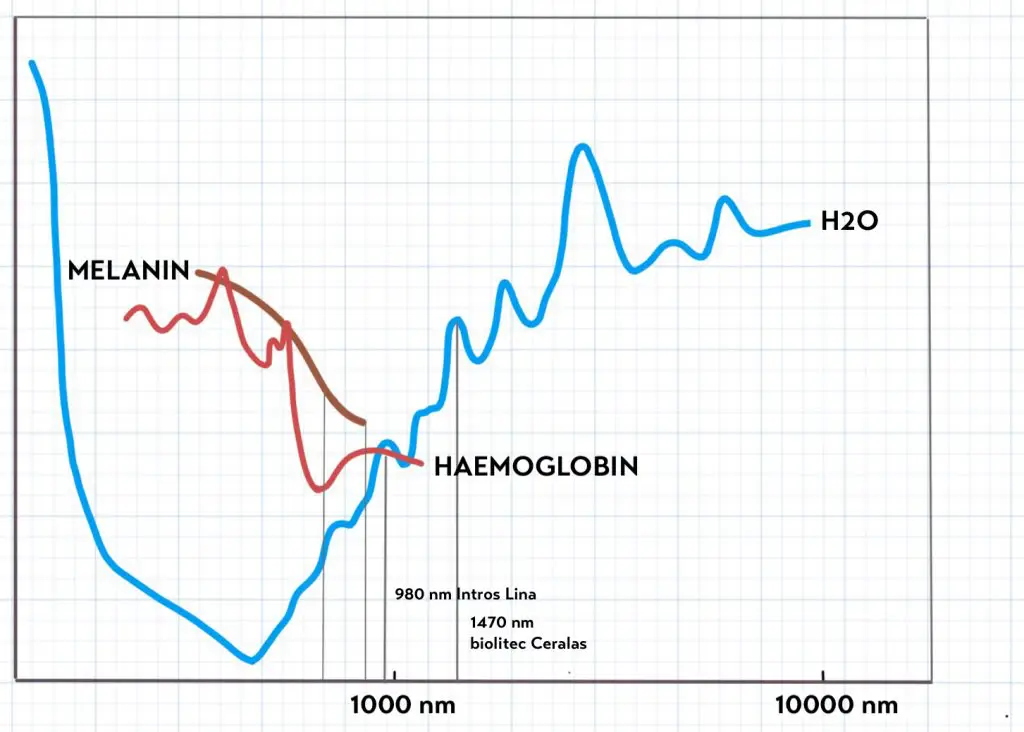
Einstein and the laser
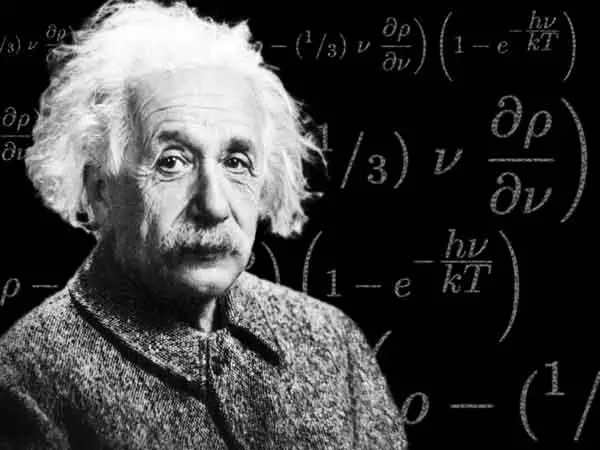
When Albert Einstein studied the question of how stars emit their light, he succeeded in deriving "an amazingly simple law", which he then published under the title "Radiation emission and absorption according to quantum theory".
Light Amplification by Stimulated Emission of Radiation: On May 16, 1961, the American electrical engineer and physicist Theodor Maiman at the Hughes Research Laboratories succeeded in converting Einstein's flash of inspiration into a functional laser with the first ruby laser.
The publication of this pioneering act was initially rejected. Maiman was nominated twice for the Nobel Prize, but the highest scientific award went to his rival Charles Townes of Bell Labs.
Today, lasers are also indispensable in medicine. In particular, the diode lasers that followed Robert Hall's gallium arsenide laser in 1962 led medicine and surgery into a new era with the availability of handy, powerful lasers.
In 1967, while trying to treat tumours by laser at the University of Budapest, Endre Mester accidentally discovered the healing effect of low-energy laser radiation and thus laid the foundation for LLLT (low level laser therapy).
Laser equipment in our practice
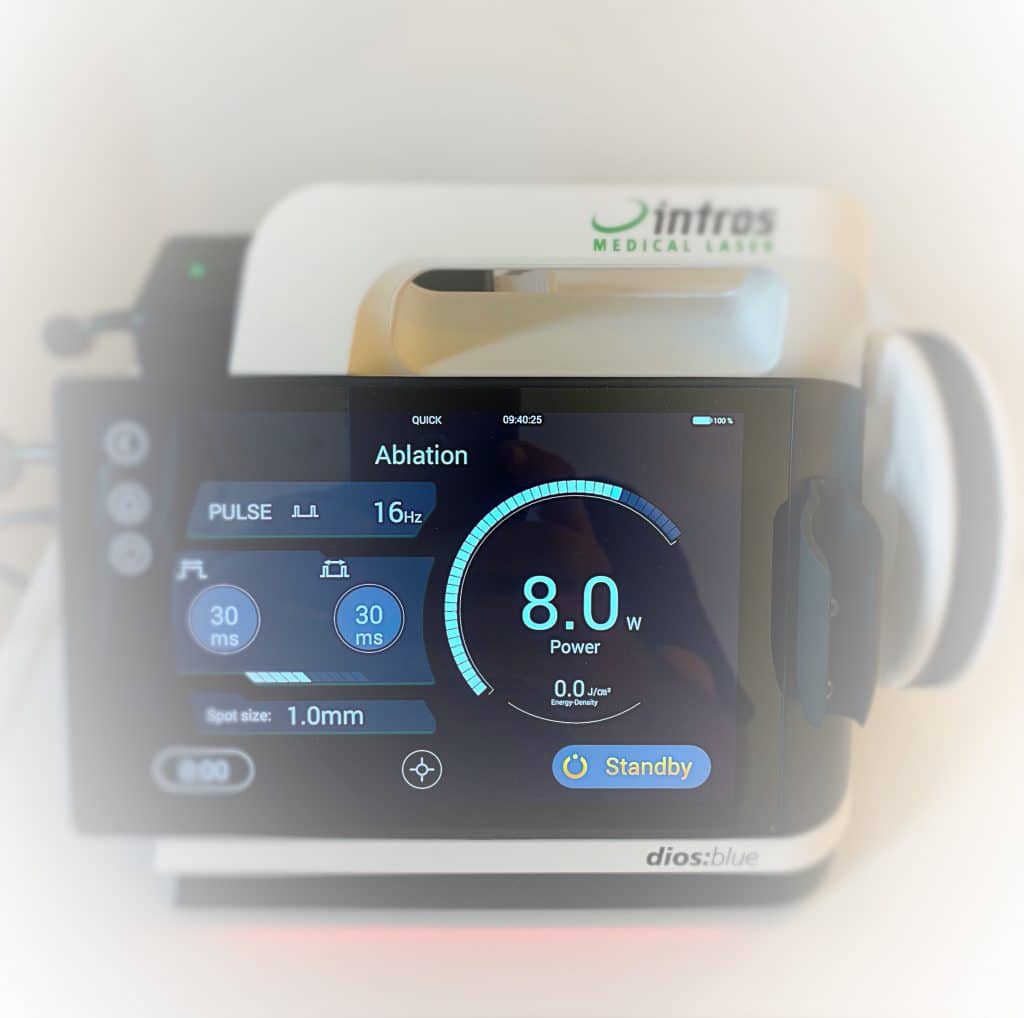
Intros Dios Blue
Despite its apparently low power of maximum 10 W, this laser opens up completely new possibilities for laser surgery: With its optimized effect on hemoglobin and melanin, it cuts precisely along the well perfused fistula capsule. The low penetration depth into the tissue protects the healthy environment even better than infrared lasers. The subcutaneous fatty tissue, which is rich in water due to the tumescent anaesthesia (a special form of local anaesthesia) we use, absorbs almost no energy at all, thermal collateral damage is minimised.
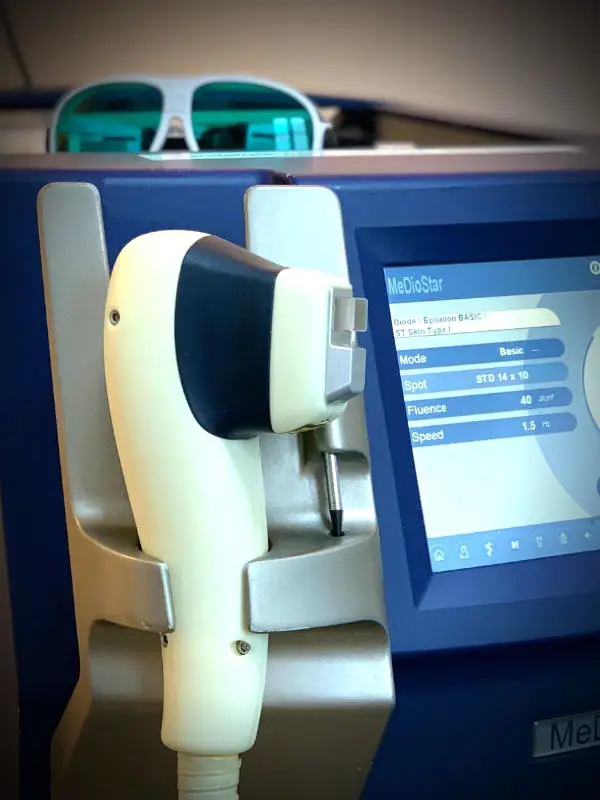
Already in the Stone Age, more than 25000 years ago, people are said to have scraped off unwanted hair with sharp shells and stones. The Egyptians at the time of the Pharaohs mixed a depilatory paste made of sugar, lemon juice and rose water ("Halawa"). Permanent hair removal was only possible with electric current or light energy.
Hair removal now represents a worldwide growth market with an estimated volume of 1.35 billion dollars and annual growth rates of 10%. In medical applications, we benefit from this development through the availability of a mature and safe technology.
The melanin in the hair absorbs the energy of the laser. The hair is thereby heated to over 61°C, the hair root is inactivated. The integrated cooling system protects the skin.
Our hair roots are always in different growth phases. The laser works best on thick, pigmented hair in the Anagen phase. In the resting (telogen) phase, the hair root contains no hair and therefore does not absorb any energy. By repeating the treatment every 4 - 6 weeks, all hair roots are gradually reached once in the Anagen phase.
The treatment works the better, the lighter the skin and the darker the hair. In studies, laser treatment was twice as effective as electro depilation. Only with light blonde or white hair does the laser reach its limits.
We observe a very good treatment result after 4 - 8 treatments in a time interval of 4 - 6 weeks. A further treatment 6 months after the end of treatment seems to improve the long-term effect.
| Author | Year | Quantity | Follow up (months) | % Recurrences | Advantage laser |
|---|---|---|---|---|---|
| Conroy | 2008 | 14 | 12 | 0 | k. K. |
| Sample #2 | Row 2, Content 1 | Row 2, Content 2 | |||
| Sample #3 | Row 3, Content 1 | Row 3, Content 2 |
diode laser 980 nm
Intros Lina-30i
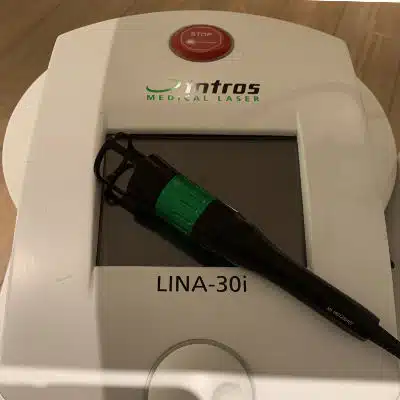
Laser surgery: Proctology
The near-infrared light at 980 nm is absorbed in equal measure by water and haemoglobin, the red blood pigment.
This laser is therefore a universally applicable laser scalpel for all laser operations on the anus.
In our hands, it has proven itself very well in operations on the rectum. The removal of anal fistulas, anal fissures and haemorrhoids can be performed precisely and with little bleeding. The focused energy is gentle on the surrounding tissue.
Wounds heal faster than with surgery using the common electro scalpel. The resulting scars are usually smooth and not very conspicuous and have sufficient elasticity and tear resistance. For the surgery of Pilonidal Sinus we now prefer the Intros Dios Blue Laser.
Low Level Laser Therapy (LLLT)
The effects of photobiostimulation are well studied 50 years after its discovery. LLLT has long been successfully used in the treatment of wounds in diabetic foot syndrome and venous leg ulcers.
Low intensity laser radiation (500 mW - 5 W) is used, which penetrates the tissue up to a maximum of 3 cm. The effect on wound healing is enhanced by applying dye solutions (methylene blue, toluidine blue) (photodynamic therapy PDT).
The treatment is performed 1 to 2 times a week, lasts about 5 minutes and is painless. The patients feel a pleasant deep warmth. Areas of application in our practice are anal venous thrombosis, chronic anal fissure and wound healing disorders after surgery of a Pilonidal Sinus. This therapeutic principle is also worth trying for stubborn eczema, nail fungus disease (onychomycosis), early stages of herpes simplex and psoriasis.
- Cellular mode of action: In the cellular domain, the focus is on activating the mitochondrial respiratory chain and increasing adenosine triphosphate (ATP) synthesis by up to 400 %. ATP is a universal
energy carrier for all cell functions and thus promotes the stabilisation of the cell membrane via the enzyme calcium ATPase and the protein synthesis via transcription factors (NF-B). - Circulatory principle of action: In the area of wounds and inflammations, microcirculation is often disturbed and the tissue is undersupplied with oxygen and nutrients. After laser treatment, blood circulation is promoted by the release of vasoactive peptides (substance P and CGRP) and nitric oxide (NO). The NO molecule is known as a mediator in the treatment of circulatory disorders of the heart (angina pectoris) and the potency drug Viagra. It also promotes the formation of new capillaries (angiogenesis).
- Anti-edematous mode of action: Edema is the increased accumulation of water in the tissue, which often occurs in the case of inflammation or injury. It has been shown that laser treatment leads to a stabilisation of the mast cells with the consequence of a reduced release of histamine. In addition, the improved microcirculation also contributes to the reduction of swelling.
- Antiphlogistic (against inflammation) principle of action: mediators of inflammation, especially prostaglandins and TNF, are reduced after laser treatment, the cells of the immune system are stimulated. Bacteria, fungi and viruses are inhibited in their multiplication by laser energy.
- Tissue reparative principle of action: in the first phase after an operation, wounds cleanse faster, in the healing phase that follows, the formation of new tissue is promoted by stimulating fibroblasts (connective tissue cells) and synthesis of elastic and collagen fibre proteins, and the formation of keloids is reduced.
- Analgesic principle of action: The factors affecting the healing effect naturally also reduce wound pain. In addition, there is a stabilisation of the membrane potential of the sensitive nerves and a segmental pain-relieving effect through the release of endorphins at spinal level.
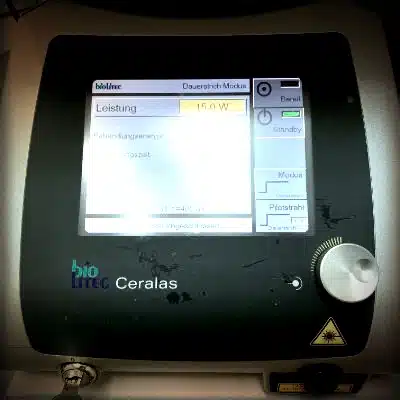
Biolitec Ceralas 15
The biolitec was the first laser in my practice. This laser delivers light of one wavelength, which is well absorbed in water and is therefore particularly well absorbed in tissue containing water. It is the first choice for laser sclerotherapy of hemorrhoids, where the enlarged hemorrhoids are shrunk by applying the laser energy in the center of the node (laser hemorrhoidoplasty LHP). In addition, this laser is also well suited for FiLaC/SiLaC therapy of the pilonidal sinus and anal fistulas and for the treatment of varicose veins (varices).